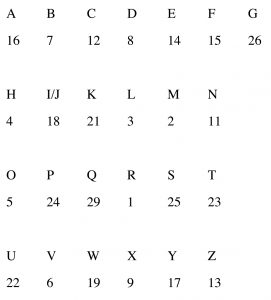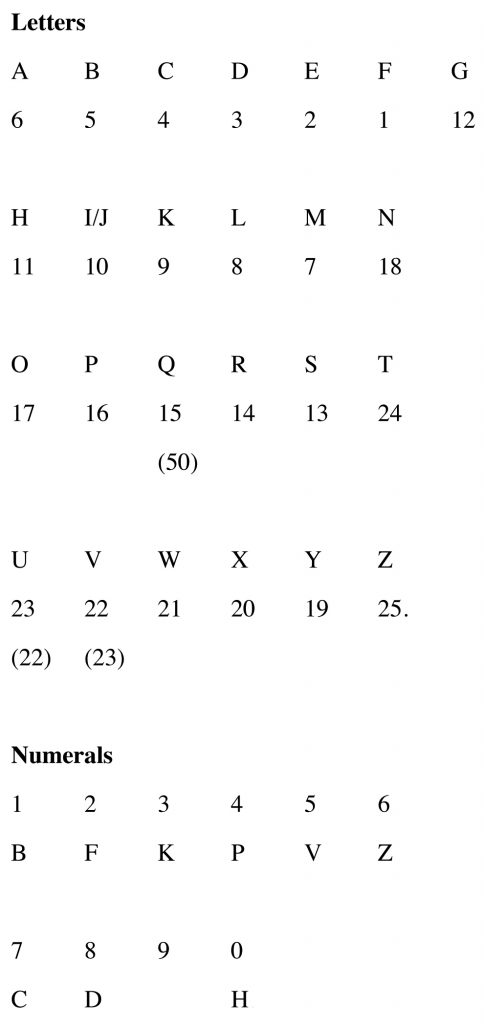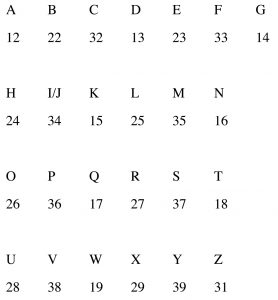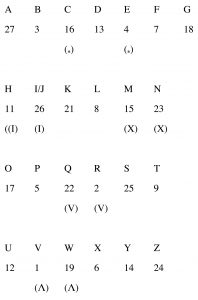During the southern campaigns the British used two kinds of cipher, each kind being markedly different from the other.
The First Kind of Cipher: The Common Cipher
Earlier this year I was asked by an American historian[1] if I could decode the cipher in the following letter from Col. Francis Lord Rawdon, commanding in the upcountry of South Carolina and Georgia, to Lt. Col. John Watson Tadwell Watson,[2] being a cipher which had not been broken for 238 years:
On close analysis it soon became apparent to me that the cipher was the Common cipher, which was more widely used in the south, for example in correspondence between Lt. General Charles Earl Cornwallis, the British General Officer Commanding there, and the following officers: Rawdon; Lt. Col. George Turnbull when commanding at Camden, South Carolina; Lt. Col. Banastre Tarleton, when in the field; and Major James Henry Craig commanding at Wilmington, North Carolina. They in turn made use of it when corresponding at times with their subordinates. When Watson returned to New York in early summer 1781, he took the cipher with him and it was used by General Sir Henry Clinton, the British Commander-in-Chief in North America, in his dispatch of July 11, 1781 to Cornwallis,[3] who had by then entered Virginia.
The enciphered words read:
“[If your intelligence corresponds with this,] you will please to send Fanning’s Regt hither as quickly as possible and Small’s may return to Monk’s Corner.”
As far as the enciphering device was concerned, it had two concentric rings, the outer of which consisted of the letters of the alphabet in their normal order, and the inner a series of numbers in a permanently fixed order. To form the cipher the numbers in the inner ring were aligned with the letters in the outer, and the key to the cipher was the number aligned with the letter “A”, a number which always appeared first in an enciphered document. It was therefore a simple matter for the recipient to make the same alignment and so decipher the document. Numbers not part of the cipher were inserted to confuse an unauthorised recipient, in this case any number from and including “30” onwards, which had no meaning. Occasionally, but not here, other numbers were added to those that were part of the cipher. For example, if “N” were “6” it might sometimes be enciphered as “36” or “46”.
As to the use of the cipher here, the key is the number “16” in the opening sequence “33, 16, 41”, with “16” being aligned with the letter “A”. As previously explained, “33” and “41” have no meaning. When set to this alignment, the cipher reads as follows:
The cipher is capable of twenty-five alignments. If, for example, “8” is inserted first at the beginning of enciphered text (disregarding the insertion there of numbers that have no meaning), then that number is aligned with the letter “A”. Consequently B, C, D, E etc. are automatically enciphered as 14, 15, 26, 4 etc. by virtue of the fact that they appear sequentially after “8” in the cipher (exactly as the same sequence after “8” appears in the cipher used in Rawdon’s letter above).
The circumstances surrounding the dispatch of that letter are set out in the following report of the same date from Rawdon to Cornwallis, who was at this time conducting the winter campaign in North Carolina.
Camden
March 7th, 1781
Earl Cornwallis etc. etc. etc.
My Lord
I have been in the field ever since I wrote the enclosed. I am grieved (altho’ it is merely a gazette) that during my absence no means could be found of transmitting it to you, as I know how anxious your Lordship must be to hear frequently from us, but the savage cruelty of the enemy, who commit the most wanton murders in cold blood upon the friends of Government that fall into their hands, makes it very difficult to procure a messenger at any price.
A very daring effort has been made to excite revolt in this province, but as the project is I think entirely baffled, the circumstance will probably conduce to our future tranquillity by having exposed to those whose sentiments were wavering how little prospect of success can ever attend such an enterprize. I mentioned to your Lordship that I relinquished the pursuit of Marion[4] upon intelligence that Sumter was assembling a considerable force near Fishing Creek and the higher fords of Broad River. Ninety Six I supposed to be his object. Notwithstanding my utmost pains to secure early information, Sumter had gained the banks of the Congaree before I received the least notice of his movement. Upon the first intimation of this step I marched with six hundred, an hundred cavalry and two pieces of cannon)[5] hoping to get upon the enemy before they could learn that I was in the field. On the first day’s march I got certain information that Sumter had crossed the Congaree at Friday’s Ferry and had invested Major Maxwell’s post, a square redoubt enclosing two or three storehouses. Wade Hampton was in contract to furnish a certain quantity of provision to this post on a fixed day. As he maintained a secret correspondence with Sumter, he delayed fulfilling his agreement till he thought the stores in the redoubt were all expended, of which circumstance he gave Sumter notice. Sumter therefore concluded that a blockade of a few days would reduce Major Maxwell to surrender. In the meantime he summoned by proclamation all the inhabitants to join him, offering to all such as would take part with him a full pardon for their former attachment to us and denouncing penalty of death to all who did not range themselves under his standard by the 23rd of February. To give weight to these threats several persons known to be friendly towards us were inhumanly murdered, tho’ unarmed and remaining peaceably at their own houses. Either thro’ fear or inclination many joined the enemy, and several parties were in movement for the same purpose when Sumter received the news of our approach. I had detached Major McLeroth with 260 infantry and a piece of cannon to bar the enemy’s retreat at Friday’s Ferry whilst I endeavored to get round them. We crossed Broad River at a ford deeper, wider and more rapid than Lands Ford on the Catawba. Above thirty of the infantry were carried away by the force of the stream, but fortunately they were all saved (excepting one man of my light company)[6] by the exertions of some of the New York dragoons,[7] who were stationed lower in the ford for that purpose. The Saluda was so swollen that it was not fordable, but we passed it securely at Weaver’s Ferry on the 22nd of February under cover of our cannon. Here we learned that Sumter had retired down the Congaree the night before, having had information of our march from the fugitives of some parties which we had fallen in with and dispersed as they were on their way to join him. I was likewise informed that Major McLeroth, deceived by false intelligence, had crossed the Congaree at Friday’s Ferry instead of moving down to meet the enemy at McCord’s as had been intended. To prevent loss of time I sent Major McLeroth directions to follow the track of the enemy, and I detached the cavalry to join him. Advancing with the remainder of my force to Friday’s Ferry, I crossed the Congaree at that place during the night of the 23rd and next morning struck across the fork by forced marches in expectation of falling in with the enemy between McCord’s and Camden. I soon learned that the enemy had met and taken sixteen waggons laden with public stores near Buckhead’s, the goods contained in which they had put into the boats at McCord’s Ferry and sent them down the Santee, they themselves pursuing the route along that river with intent to cross it at Manigault’s as the only means of escaping . Sumter had made an attempt upon the post at Thompson’s but was repulsed by Captain Robinson of the Provincial light infantry, who commanded there. This information I received from Major McLeroth with an intimation of his purpose to pursue Sumter immediately. I crossed the Wateree at Camden on the evening of the 25th, and on the 26th continued my march towards Neilson’s, having sent forward instructions that Lt. Colonel Watson, who was on the High Hills, should hasten before me to Manigault’s and that the post at Wright’s Bluff should be on the watch for the boats. Sumter had in the mean time ordered Marion to advance to Manigault’s and cover the passage from being interrupted by Watson. Our movement, however, prevented Marion from attempting to interfere, and the boats (in which Sumter had hoped to pass the river) were retaken with all the baggage as they attempted to pass Wright’s Bluff. Lt. Colonel Small was advancing from Monk’s Corner with the 84th and Fanning’s Regiment, so that Sumter’s retreat appeared scarcely possible, but, upon a rumor that Marion had crossed the Santee and joined Sumter, Major McLeroth unfortunately discontinued the pursuit. Sumter, finding that his rear was not pressed, undertook to cross the Santee by swimming his horses and passing his men in two canoes which he found by accident at Fludd’s Plantation. He effected his purpose on the 27th and the same evening fell in with Lt. Colonel Watson. An action ensued in which the enemy were forced to flee, leaving 18 dead on the field, several wounded and about forty horses. Our loss was only a subaltern and seven privates wounded. Harrison’s people, mounted and armed with swords, behaved very gallantly, routing the enemy’s cavalry regularly formed and thrice their number. Finding on my arrival at Neilson’s Ferry that Sumter had gotten clear into the country and had ensured a junction with Marion, I thought it very probable that upon learning my distance from Camden the enemy might be tempted to make a joint effort against it. Therefore, ordering the infantry of Major McLeroth’s detachment to cross the Santee and join Lt. Colonel Watson, I returned hither as rapidly as possible with the infantry which had accompanied me and with the cavalry, which had just rejoined me by way of Neilson’s Ferry. I arrived here about noon on the 5th instant, and on the same evening I detached Major Fraser towards Ratcliff’s Bridge with the South Carolina Regiment, which had formed part of the garrison of Camden during our march. The cavalry were to have been of the party, but a considerable body of the enemy having appeared at a plantation not very wide of the route to be pursued by Major Fraser, I ordered that the cavalry should first attempt to strike at that corps and afterwards join the South Carolinians. These directions proved unfortunate. The corps at which the cavalry were to strike got information of their approach and escaped thro’ the swamps; and on the 6th, before the cavalry had joined him, Major Fraser unexpectedly met Sumter near the head of Black River. Sumter, ignorant of our return, was advancing towards this post to attempt fulfilling a particular purpose, which, an intercepted letter informs me, was enjoined by Greene,[8] and he was not a little surprised at finding himself opposed in the open field. When the parties first met, Sumter’s men were all mounted and quickly gave way before the fire of the infantry. They soon, however, dismounted and advanced with tolerable countenance to attack Fraser. The South Carolinians soon repelled the attack and entirely dispersed the enemy, pursuing them for some distance, but for want of cavalry no decisive advantage could be taken of the rout. The enemy lost ten killed and about forty wounded. Fraser had only six wounded. Marion was not with Sumter in this affair, and I believe from every circumstance that, finding the country deterred by his ill success from joining him, Sumter is retiring towards his old haunt near the Catawba lands. Sumter’s force, when he crossed the Congaree, passed current for at least a thousand, but I am convinced it scarcely exceeded four hundred. They were all mounted. About a fourth of them were armed with swords as cavalry and had excellent horses. Of those who joined Sumter at Congarees, none I believe passed the Santee with him. Marion’s numbers certainly do not amount to three hundred. Lt. Colonel Watson has orders to press him to the utmost. I should not, my Lord, have thought so long a detail of our petty operations worth sending to you, only that I know a variety of rumors must reach you, which could not be explained by a less minute account. I would say that we have had great fatigue, were I not ashamed to mention it after the wonderful exertions which you have been making. Lt. Colonel Watson, Major Fraser and Major Maxwell have all acquitted themselves very handsomely. The New York dragoons have distinguished themselves in many successful skirmishes; Captain Coffin particularly merits applause. I have not heard from your Lordship since you left Salisbury, but some intercepted letters from the enemy give me an idea of your purposes. Campbell with the Back Mountain men and Pickens are gone to join Greene. The fatigue of our little excursion has given me a cough and something of a feverish complaint. I fear your Lordship must look out for some one to relieve me. I hope to leave the district in a state of tolerable quiet. Whilst I am wanted I will do my utmost, but I doubt my strength.
I have the honor to be, my Lord, with equal respect and affection
Your Lordship’s very faithful servant
[Subscribed:]
I have taken the liberty of permitting Major McLeroth to go to New York. It was become too necessary.[10]
[Enclosure:]
Camden
February 15th
I am just returned, my dear Lord, from my excursion after Marion. I found that his numbers did not much exceed three hundred. By forced marches we got below him but he got off (tho’ narrowly) across Scape Whore. We forced him over Lynches Creek and should have driven him across Pedee had not news of a corps advancing against Ninety Six recalled me. I find since from Cruger that the enemy are not in greater force than what Cunningham thinks himself equal to, but I take it for granted some effort will be made in that quarter. I therefore remain ready to march at one hour’s warning. In the mean time I have taken measures which I hope will prevent Marion from troubling us much more.
…
RAWDON[11]
Other Ciphers of the First Kind
The way in which these ciphers are set, the use in them of numbers having no meaning, and the expanding at times of numbers forming part of the ciphers ― all are the same as described above in connection with the Common cipher.
Ferguson’s Cipher
This cipher was used in the late summer and autumn of 1780 not only by Major Patrick Ferguson, the Inspector of Militia in South Carolina, but more widely. Because of the risk that it had fallen into enemy hands, its use was discontinued after the Battle of King’s Mountain on October 7, a battle in which Ferguson was killed and his men killed or captured. When, for example, the first operative number in the cipher is “6”, being aligned with the letter “A”, the cipher reads as follows:
Balfour’s Cipher
This cipher was used in some of the correspondence between Lt. Col. Nisbet Balfour, the Commandant of Charlestown, and Cornwallis. It operates in the same way as the preceding ciphers.
In 1781 Balfour forwarded a copy of the cipher to Brig. Gen. Benedict Arnold in Virginia, who used it to correspond with Cornwallis during the latter’s march there through North Carolina. On arrival Cornwallis appointed Major Gen. Alexander Leslie to command at Portsmouth and used the cipher in correspondence with him.
The Ninety Six Cipher
For use in the manner previously explained for certain correspondence to or from Ninety Six.
The Second Kind of Cipher: Balfour’s Alternative Cipher
This cipher was used on a few occasions in correspondence between Balfour and Cornwallis. The enciphering tool was a dictionary, with identical copies being kept by the sender and recipient. Each word was enciphered by three numbers: the first referred to the page number, the second to the column on the page, and the third to the position of the word in the column. For example, “281-1-25” meant the twenty-fifth word in the first column on page 281. To indicate use of the cipher Balfour and Cornwallis placed “B” before the first word of enciphered text.
The dictionary used was John Entick’s New Spelling Dictionary, teaching to write and pronounce the English tongue with ease and propriety (London, 1777 edition), a copy of which is available for inspection in the Sterling Sub-Library, Senate House Library, University of London. Unlike other dictionaries of the period, it numbers each page, and almost all entries in a column occupy only one line each, making it ideal for a simplified enciphering tool.
An example of the cipher in use is the following extract from Balfour’s dispatch of October 22, 1780 to Cornwallis,[12] with the enciphered words again being italicised and underlined:
“The vessels will be ready when you order them, with every thing I can think of. Cruger is much distress’d at 96 about the militia.”
The words in question are enciphered as follows:
The 373-1-16 of 259-1-31
vessels 391-1-35 distress’d 132-2-30
you 426-1-36 at 53-2-6
order 262-1-29 about 34-2-21
them 373-1-23 the 373-1-16
think 374-1-17 militia 242-1-26.
I have come upon no evidence that any of the above ciphers was ever broken by the revolutionaries.
[1]C. B. Baxley to Ian Saberton, email of February 13, 2019.
[2]The letter, which had been intercepted by the enemy, appears in R. W. Gibbes ed., Documentary History of the American Revolution (Columbia, SC, 1853), 3: 31-2.
[3]Ian Saberton ed., The Cornwallis Papers: The Campaigns of 1780 and 1781 in the Southern Theatre of the American Revolutionary War (“CP”), 6 vols (Uckfield: The Naval & Military Press Ltd, 2010), 5: 139.
[4]For comprehensive biographical notes on persons mentioned in this letter and the enclosure, see CP, passim.
[5]Words in this letter that are italicised and underlined were enciphered. It is the Common cipher that was used.
[6]Rawdon was Colonel of the Volunteers of Ireland, a British American regiment raised at his own expense.
[7]A large part of the New York Volunteers, another British American regiment, had been converted by Rawdon into cavalry.
[8]In a letter of February 21, 1781 Greene had invited Sumter to destroy a mill near Camden as a means of forcing the garrison to abandon the post through lack of supplies. Richard K Showman et al. eds, The Papers of General Nathanael Greene (Chapel Hill: University of North Carolina Press, 1994), 7: 328.
[10]Because, as evinced by the present affair, McLeroth was not an effective officer.













3 Comments
Just for general interest, I should note that the code described as the “Balfour Alternative Cipher” was actually a rather standard book code used extensively throughout the war by both sides. Not unlike a one-time pad, breaking it required knowing what book, and edition of the book, was being used.
Benedict Arnold and Major Andre attempted, with problems, to use the book code in some of their correspondence.
It is a relatively easy code to use and can be un-coded quickly compared to other ciphers.
Thank you, Ken, for your comments, which I agree with. If the article was to be comprehensive, Balfour’s alternative cipher had of course to be included, no matter how simple it was.
This is fascinating and incredibly useful, thank you! I’ve been working intimately and personally with a lot of these documents (especially Rawdon’s letters and reports).
I’m writing my undergraduate history thesis on British Ciphers and Intelligence work during the American Revolutionary War, and I was wondering if you had any sources or citations regarding how you decoded these. (Such as peer-reviewed articles and whatnot.) There are very few published works (especially on these ciphers) and I would be grateful for any leads, sources, or ways to cite this work in my academic studies. I would very much appreciate being able to compare my own understanding of these codes with the presented scholarship. Thank you so much!